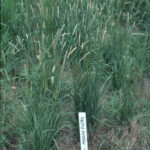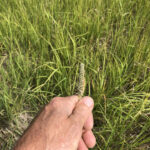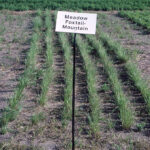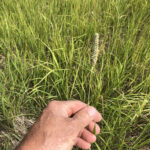Meadow Foxtail
Alopecurus pratensis
General Description
Meadow foxtail is a long-lived, early maturing, bunch grass. It spreads by seed, not rhizomes. The seeds are light to medium grey, and can be transported to a new location by wind or water. It is highly adapted to moist riparian areas, but can become invasive. Creeping foxtail is a similar species, but has aggressive creeping roots and seeds are generally black in colour. The two species can cross.
Meadow foxtail stems usually grow less than 1 m tall (3.3 feet), with leaves up stems. Leaves are smooth and soft. They are generally less than 8 mm wide (narrower than creeping foxtail leaves). As meadow foxtail self seeds it becomes a mat of sod. Meadow foxtail heads are a similar shape to timothy. Meadow foxtail is commonly seeded on peat and muskeg sites, sloughs, flood plains with very high water tables and other wet areas.
Type
Tame grass.
Origin
Europe and Asia.
Longevity
At least 20 years.
Use
Pasture, hay. Early maturing can cause difficulties in timely use of meadow foxtail. Grazing after haying is an option for a meadow foxtail stand.
Optimal Time of Use
Spring, summer. Meadow foxtail can be continually or rotationally grazed, but responds best to rotational grazing. Meadow foxtail grows early and should be hayed or grazed before flowering during mid-June (area dependant). Meadow foxtail can serve as an early season grass (lengthens grazing season at the start of the year). Hay and graze to avoid seed head formation and consequent reduction in palatability.
Recovery After Use
Requires a minimum 45-60 days of recovery after use. Meadow foxtail recovers very quickly after grazing when moisture is available. Utilize early to a height of approximately 10 cm (4 in) to keep vegetative.
Palatability/Nutritional Value
Meadow foxtail is palatable and nutritious when vegetative, but quality declines rapidly as plants mature. Grazing livestock select against mature meadow foxtail when other species are present in the pasture.
Annual Precipitation min/max (mm)
460mm/ 1500mm
Drought Tolerance
Poor tolerance. Requires moist soils.
Flooding Tolerance
Withstands two to five weeks of spring flooding, or ongoing wet soils. It grows best on wet soils found in and around wetlands and lowlands.
Winter Hardiness
Good to excellent hardiness.
Soil Texture Preference
Moist clay-loam to clay soils. Moisture is needed to maintain meadow foxtail.
Erosion Control
Moderate ability to control erosion. Meadow foxtail is useful for stabilizing waterways and banks, but its sod is inferior to reed canary grass for this purpose. Meadow foxtail has the ability to displace native vegetation in waterways through self seeding.
Salinity Tolerance
Not tolerant to salinity.
Acidity Tolerance
Moderate tolerance. Varieties with higher tolerances are available.
Alkalinity Tolerance
Moderate tolerance.
Seeds per kg
897,000 seeds/kg (407,000 seeds/lb)
Suggested Mixtures
Often grown as a pure stand due to its very early maturity and suitability for wet areas. Meadow foxtail is effective in a mix with alsike clover, or other competitive legumes such as alfalfa or red clover. The mix should be managed to keep meadow foxtail in the vegetative stage (palatable).
Ease of Establishment
Meadow foxtail is easy to establish with sufficient moisture. Allow enough time between seeding and fall for growth to be winter hardy. Seed is tolerant of flooding. Plants readily establish from self-seeding.
Competitiveness
Meadow foxtail is very competitive in riparian habitats. Seeds easily spread by wind and water.
Management Considerations
Management of meadow foxtail to stop heading is important so that the forage is useful (palatable) for grazing or haying. If possible, fence meadow foxtail into a separate paddock to be grazed as needed to manage for palatability. Caution needs to be taken if soils are saturated to prevent soil compaction. Stands of meadow foxtail tend to thicken as some seeds set yearly. Meadow foxtail can move into riparian areas so care should be taken when deciding on seeding riparian margins.
Saskatchewan Dryland Forage Species Adaptation Tool, USDA Plants Database, Manitoba Forage Adaptation Tables, Alberta Forage Manual
Meadow foxtail is adapted to moist areas in the Sub-Boreal Spruce, Sub-Boreal Pine-Spruce and Interior Cedar-Hemlock zones. It is adapted to moist or subirrigated areas in the Interior Douglas-fir in the southern part of the region.
Meadow foxtail is adapted to moist or subirrigated areas in the Interior Douglas-fir and Interior Cedar-Hemlock zones.



